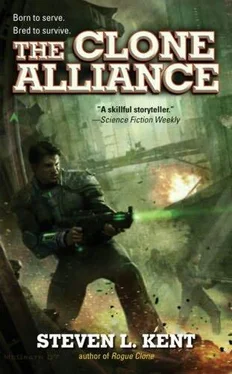Steven Kent - The Clone Alliance
Здесь есть возможность читать онлайн «Steven Kent - The Clone Alliance» весь текст электронной книги совершенно бесплатно (целиком полную версию без сокращений). В некоторых случаях можно слушать аудио, скачать через торрент в формате fb2 и присутствует краткое содержание. Жанр: Боевая фантастика, на английском языке. Описание произведения, (предисловие) а так же отзывы посетителей доступны на портале библиотеки ЛибКат.
- Название:The Clone Alliance
- Автор:
- Жанр:
- Год:неизвестен
- ISBN:нет данных
- Рейтинг книги:4 / 5. Голосов: 1
-
Избранное:Добавить в избранное
- Отзывы:
-
Ваша оценка:
- 80
- 1
- 2
- 3
- 4
- 5
The Clone Alliance: краткое содержание, описание и аннотация
Предлагаем к чтению аннотацию, описание, краткое содержание или предисловие (зависит от того, что написал сам автор книги «The Clone Alliance»). Если вы не нашли необходимую информацию о книге — напишите в комментариях, мы постараемся отыскать её.
Rogue clone Wayson Harris is stranded on a frontier planet-until a rebel offensive puts him back in the uniform of a U.A. Marine, once again leading a strike against the enemy. But the rebels have a powerful ally no one could have imagined.
The Clone Alliance — читать онлайн бесплатно полную книгу (весь текст) целиком
Ниже представлен текст книги, разбитый по страницам. Система сохранения места последней прочитанной страницы, позволяет с удобством читать онлайн бесплатно книгу «The Clone Alliance», без необходимости каждый раз заново искать на чём Вы остановились. Поставьте закладку, и сможете в любой момент перейти на страницу, на которой закончили чтение.
Интервал:
Закладка:
Bigger wrecks loomed in the distance. No lights showed through their portholes, and their observation decks were dark. We passed within a couple hundred feet of a U.A. fighter carrier. I could see its fatal wounds. Ten-foot-wide holes dotted the front section of its bow. The big ship hung motionless.
“They’re like ghosts,” Illych said as he fastened his armor. He looked tense as he checked and rechecked his gear.
Maybe it was SEAL culture or maybe it was in their programming, but Adam Boyds behaved differently than Marines before combat. General-issue clones hid their nerves behind crude jokes and loud boasting as they waited for the doors to open on a mission. Clones who were too scared to bluff became sullen and sometimes despondent. These guys carried on quiet conversations. They talked about sports or plans for the next time they took leave. Did they feel nervous at all? I wondered. Fighting in open space would take them out of their element.
Marines wore armor in all combat situations. SEALs did not. They had armor for deep-space operations, but I doubt they found much use for it. While I practically jumped into my armor, they moved more tentatively. They fastened their armor on one piece at a time. Watching them, I was reminded of a swimmer climbing into cold water. I wondered if their helmets made them claustrophobic.
Working in armor did not make me nervous, but the derelict fighters floating around our ship gave me a shiver. The explorer pushed through this graveyard at a slow drift, giving us a good look at each broken craft as we slid by. Around us, everything was silence, stillness, and death.
The old sailors who traveled Earth’s seas were said to have loved the ocean. The great captains said they were married to the sea or called the sea their mistress. Modern sailors held no such fantasies about outer space. Space did not love or hate, it simply killed anything it touched.
“Pardon me, sir, but what are we looking for out here?” one of the Boyd clones asked. So far, the Boyd clones kept to themselves mostly. It took a moment before I realized that someone had asked me a question.
The man who had approached me had scars around his mouth and nose. Several white lines streaked his lips and faded into his chin. All of the Boyds bore scars. They were inevitable when you did not wear armor in battle.
“Sir,” the clone repeated, “what are we looking for on the Mogat ship?” If this SEAL was scared, he hid it well. I would have described him as “on edge,” but not scared.
“I want their broadcast computer for openers,” I said. “If we can figure out where their ships have been, we might be able to drop in on the Mogats’ home base.”
The Boyd nodded. I did not need to elaborate about what treasures that computer might hold. If the boys back in Naval Intelligence could tap into its databanks, assuming the databanks had survived the battle, we might find enough information to win the war.
Functioning battleships give off virtual beacons that identify their name and fleet. According to Admiral Porter’s report, a derelict Mogat battleship lay somewhere in this mess; but the ship’s computers had all gone dark. We could not locate the beacon, so we had to fly past every wreck and identify it by sight.
“Colonel Harris,” a voice called over the intercom.
“Have you got something?” I asked.
“We found their ship,” the pilot said.
“I’m on my way,” I said. I turned to Illych. “You want to come up?”
He nodded.
The explorer had three distinct compartments—a cockpit, a cabin for passengers, and a cargo area/engine room. The SEALs had moved to the cargo hold waiting to deploy, leaving the cabin empty.
One of the chief uses of this particular ship was space cartography. It had an all-glass cockpit. Looking at the view from the cockpit felt like floating in space. The only light in the pilot’s area came from the low glow of the instrumentation.
“It’s that one over there,” the pilot said, pointing at a huge wreck. The explorer moved very slowly past the wreckage of a Tomcat, nudging the crumpled fuselage out of its way.
Off to the right, I saw the target. At first it looked more like a shadow than a battleship. It was a black hole in the middle of a field of stars. Then I recognized the shape—the bulbous bow and the wide-diamond hull. I did not actually see the ship. I saw the shape of its silhouette against a backdrop of stars.
Illych asked, “How do we get in?”
“That’s your problem,” the pilot said. “My job is to bring you here. I’ve done my part.”
“We look for an open door,” I said.
Illych nodded. As he turned to leave the cockpit, he said, “I thought you would say something along those lines.”
We went back to the cargo hold and put on our helmets. The SEALs wore armor made specifically for them. My armor was green. Their armor had smart camouflage. As they maneuvered, sensors in their helmets would read the color and lighting in the environment, changing the color of their suits. There were limitations, the armor could only match basic coloration. It offered camouflage, not invisibility.
We stepped onto the cargo elevator at the very back of the ship. It lifted us into an air lock in the roof, where we boarded a ten-man space sled. There were only seven of us, and the SEALs were small. It might have held twelve of them.
“Are you ready, Colonel?” the pilot asked over the interLink connection in my helmet.
“Open the lock,” I said.
The metal dome that covered the air lock peeled back slowly to reveal the stars behind it. I hit the release button to retract the sleeves that clamped our sled in place. With a small burst of air, the sled dislodged from the explorer and lifted into open space.
Normally we would attach jetpacks to our armor before traversing open space. We did not on this occasion. Once we entered the derelict battleship, we would likely enter unstable areas with radiation and chemical contamination. Who could predict what we would find on that ship? We could not risk wearing jetpacks.
We had half a mile to traverse between the explorer and the battleship. As we covered the silent distance, some of the Boyd clones played their search beams along the hull of the derelict ship. The hull looked smooth and untouched from what I could see. Their lights cast yard-wide circles that bleached the ship’s armor gray. The circles of light stretched and deformed as they played over the various portholes, gun placements, and hatches.
“It doesn’t look like there are any open doors on the top side, sir,” Illych’s voice came over the interLink.
“Not that I can see,” I agreed. “Not that I can see.” I sighed. These things never came easy.
Something else was missing. Not only did I not see any breaks in the hull, I did not see scorch marks. That part of the battleship looked pristine, as if it had never been hit. We flew over the top of the diamond-shaped hull. Because of the curve of its fuselage, the battleship’s bulky wings seemed to dissolve into space.
We flew over the bridge. On a ship like this, the bridge more closely resembled government offices than the wheelhouses of the old seafaring ships. There was no wheel. The navigation was handled by a set of computers. Touring the bridge of any capital ship, you would find six large computer stations. One station handled navigation, another facilitated internal and external communications, another monitored radar and tracking, and another managed the weapons systems. Gone were the days when marksmanship mattered in ship-to-ship combat.
Gone, too, were the days when specialized technicians sat around the engine monitoring its performance. Modern ships had a set of computers that constantly checked every flange and dial.
Читать дальшеИнтервал:
Закладка:
Похожие книги на «The Clone Alliance»
Представляем Вашему вниманию похожие книги на «The Clone Alliance» списком для выбора. Мы отобрали схожую по названию и смыслу литературу в надежде предоставить читателям больше вариантов отыскать новые, интересные, ещё непрочитанные произведения.
Обсуждение, отзывы о книге «The Clone Alliance» и просто собственные мнения читателей. Оставьте ваши комментарии, напишите, что Вы думаете о произведении, его смысле или главных героях. Укажите что конкретно понравилось, а что нет, и почему Вы так считаете.











